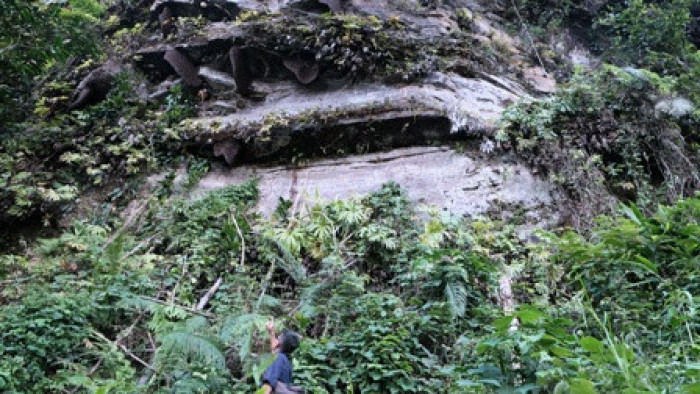
Sialang rocks in Nagari Latang (Captured by Yethendra BP)
Reportage by Yethendra Bima Putra (Journalis sumbarsatu.com)
Sijunjung, sumbarsatu.com--Wild bees have a vital role in the ecosystem and pollination of tropical rainforest vegetation, nurturing biodiversity. The honey itself is beneficial for human health and has economic value. Wild bee is also known as the Sialang bee, or Apis dorsata.
However, deforestation is crushing wild bee habitat and Sialang honey production. This was experienced by Sialang honey farmers in Kelompok Tani Hutan (KTH) Ingin Maju Nagari Latang, a kind of farmers association, Lubuk Tarok District, Sijunjung Regency, West Sumatra.
According to KTH Ingin Maju Leader, Jon Aprizal, for the last two years it was difficult to get two and a half tons of honey in Nagari Latang. Whereas in 2015-2017, during the main harvest, they could reach 4 tons and 6 tons per year.
"In the last two years, honey production in Nagari Latang has collapsed, due to forest exploitation, especially to land clearing for cultivation. Because of the weather (climate change), last year many durian flowers did not turn into fruit," said Jon Aprizal (55 years), Thursday (9/6/2022).
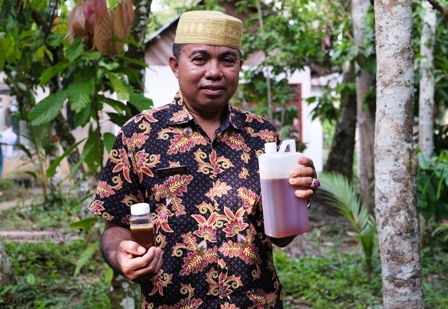
KTH Ingin Maju Leader, Jon Aprizal with Sialang Honey ready to marketed (Captured by Yethendra BP)
Nowadays, wild bees placed their nest in four rock cliffs in Nagari Latang. The trees and rocks that Apis dorsata made for their breeding ground are called sialang.
Apis dorsata usually make their nests in the hollows of rock cliffs and gummy or slippery tree branches that tall and have a large diameter. The size of the nest are about 2x1 meters, and the height ranges from 20-50 meters from the ground.
After a certain time of migration, Apis dorsata tends to regroup in the same place. Even so, the wild Apis dorsata cannot be cultivated like Apis cerana. They eat nectar from flowers in the forest.
"There were seven sialang trees in Nagari Latang, now there are only two left. The type of this Sialang tree called jolombu (rengas). In the last two years, we cannot find any wild bees that build their nest in that tree," said Jon Aprizal who is also the Chief of Nagari Latang.
No one dares to cut the sialang tree, but due to land clearing for the sake of cultivation, it fall down by itself. The wind blows harder and it tumble because there are no supporting trees arround.
"The Sialang tree and the rocks are jointly owned in Nagari Latang. Even though they are located in the fields of one resident, they cannot be claimed as belonging to individuals. Once someone claimed to own it, the tree would fell by itself," said Jon Aprizal.
The honey gather in Nagari Latang is usually done in May and the main harvest is in October-November.
"In it's season, there are dozens of nests lay on the sialang rocks and tree. A few years ago, one nest could produce 7 to 11 kilograms of honey. Nowadays it's hard to get 2 kilograms of honey," complained Jon Aprizal.
Sialang honey farmers are known as 'tukang sialang' in Nagari Latang, they harvesting using the traditional system, when the night come and the moon becomes dark. To harvesting honey at the Sialang tree, the farmers will made a wooden ladder or a lie (one) pillar which attached to the tree and it have some steps. When they harvesting in Sialang rocks the stairs are made by reeds. Other tools that they use are a bucket and plastic rope number six (they use number to mark the thickness of the rope) --also commonly used for tying cows.
There is a group of ten to twenty people of Sialang honey farmers. It consists of a handler, a folk singer, two climbers, and the workers. Climbers will climb without personal protective equipment, such as special clothing, they only need a courage and natural skill.
Meanwhile, the handler casts a spell that strengthens the climber's confidence in completing the task. And the folk singer will chanting the verse, the rhythm is like Dendang Malalak or bailau, it use to tame wild bees in their nests.
At the beehive, the farmers will make a smoke using burnt coconut husk. This way they can gather up to 80 beehives in one night.
However, said Jon Aprizal, since 2010 they do not need a handlers and folk singer anymore. Sometimes, harvesting just depend on the courage and expertise of climbers and workers.
After harvesting, the sialang honey, which has a moisture content of 24-28 percent, is processed in the AHDT P1-R90 model water reduction machine owned by KTH Ingin Maju. In the machine with a capacity of 210-240 kilograms of honey, the water content is reduced by 20 percent. The process takes 40-60 hours. Then the Sialang honey is packed into plastic bottle or blitz can with capacity of 250ml, 500ml, and 1000ml. It marketed to West Sumatra, Jambi, Riau, and even sold online in the marketplace.
The water reduction machine was the contribution from Sijunjung District Forestry Service in 2015--now the Sijunjung Protected Forest Management Unit (KPHL), one of the Forest Management Units (KPH) under the the bureaucracy of West Sumatra Forestry Service.
KTH Ingin Maju was formed in 2010. The members, commonly, are carpenters. At that time, there was a non-timber forest product (HHBK) utilization program from the Sijunjung District Forestry Service.
"In the past two years, the water reduction machine has stopped functioning, because the supply of honey has dropped drastically," said Jon Aprizal.
Jon Aprizal said that the slumping in Sialang honey production did not only occur in Nagari Latang, but also in other villages in Sijunjung Regency. In 2016, he and KPHL Sijunjung officers verified or recorded how much honey that was taken. There are 131 Sialang rocks and trees in Sijunjung Regency. But now maybe only 30 percent left.
"Just like the meranti type of Sialang tree in Nagari Silokek, Sijunjung District, now there’s nothing left," he said.
Deforestation Impact
As stated by Dr. Jasmi, M.Si (58 years old) who has studied about sialang bee since 1995, the conversion of rainforest for the plantations and settlements, or illegal logging, changing the natural habitat of Apis dorsata. It sinking the wild bees habitat and sialang honey production.
There are two type of sialang bee, agregation (group) and solitary (alone). Who have a problem with their habitat is the agregation type.
"There are no bees who produced the wrong honey, but their circumstances matters a lot to the quality of honey that they produced," said Dr. Jasmi, Biology major, Faculty of Mathematics and Natural Sciences, Andalas University, Monday (4/7/2022).
Dr. Jasmi also revealed that in 1980-1990, a Sialang tree can accommodate 200-250 colonies or nests in Pasaman and Sijunjung regencies. Due to deforestation, the colony is shrinking about to dissappear.
In the 1990s, Nagari Inderapura in the Pesisir Selatan Regency was the largest producer of Sialang honey in West Sumatra. However, the conversion of rainforest to oil palm plantations has made them no longer in charge. Oil palm flowers are not food for Apis dorsata, because they do not have nectar.
In areas where the wind was strong, strong enough to crushing the nest, It commonly happen in newly opened farm, Apis dorsata also have difficulties to return to it.
"Currently, there is no regulation to protect wild bee habitat. The government should make a law for it. In addition, it is necessary to use customary law to protect the Sialang tree. To reach a diameter of 10 centimeters it takes 4 years. And for restoring the whole rainforest it needs hundreds of years," said Dr. Jasmi.
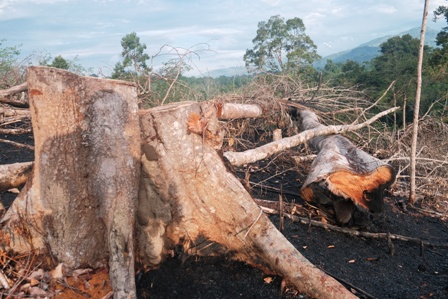
Land convertion for plantation in Lubuk Tarok Regency (Captured by Yethendra BP)
He explained, there are about thirty types of sialang trees such as terap (Artocarpus odoratissimus), meranti (Shorea), banyan (Ficus benjamina), rengas (Gluta aptera), kapok (Ceiba pentandra), and others. Aggregated wild bees generally nesting in trees with a diameter more than 50 centimeters and height more than 40 meters, with diverse branch systems.
"The tree chosen for nesting by Apis dorsata is a large and slippery tree so that it is not easy for honey-eating bears to climb on it. Their food source is forest, which provides variety of food," said Dr. Jasmi.
***
The area of Nagari Latang is 20.80 kilometers square, or 11.09 percent of the total area of the Lubuk Tarok sub-district, covering an area of 19,233 hectares. The distance from the village administration office, to the sub-district capital is 18 kilometers, to the district capital is 29 kilometers, and to the provincial capital is 151 kilometers.
Lubuk Tarok District has an altitude ranging from 124-580 meters above sea level. The altitude of Nagari Latang is 390 meters above sea level. The average temperature ranges from 24-32 Co. This is the altitude and temperature that suitable for Apis dorsata habitat.
The rainforest area in Nagari Latang is 430 hectares. It consists of 250 hectares of permanent production forest and 150 hectares of limited forest. The area of rice fields is 150 hectares and the plantation area is 550 hectares. This Nagari, which is surrounded by Bukit Barisan, is inhabited by 1,287 people in May 2022.
"There is no longer such as “The Real Forest” in Nagari Latang. It's just an administrative forest," said Jon Aprizal, who served as Chief of Nagari Latang for three terms.
For Jon Aprizal, who was also a tukang sialang in 1986-2002, he said that a real rainforest have numerous biodiversity. He can say it like that because he had entered the rimbo sansai (deep forest) looking for honey in Sijunjung, Dharmasraya, and Solok Regencies.
"Logging for industrial or illegal logging in Nagari Latang occurred in 1990. Now it no longer exists. Large wood is rare to found. Since 2018 there have been many new fields opening," said Jon Aprizal.
According to Jon Aprizal, Apis dorsata looks for food up to a distance of 8 kilometers horizontally (flying straight). Meanwhile, according to Dr. Jasmi, the effective distance of Apis dorsata foraging is up to 5 kilometers, because the farther the worker bees looking for food, the less honey they’ll produce.
Thus, if there’s lack of food in Nagari Latang, Apis dorsata will look to other areas. And at certain times, these wild bees also migrate up to hundreds of kilometers.
Not only in Nagari Latang, deforestation occurs in other villages in Lubuk Tarok District. The data from the Central Statistics Agency (BPS) of Sijunjung Regency, the rainforest area in Lubuk Tarok District has decreased. In 2015 the rainforest area was 7,208.50 hectares, consisting of 5,109.20 hectares of protected forest and 2,099.30 hectares of production forest. In 2021 the rainforest area is 6,825.19, consisting of 4,786.55 hectares of protected forest and 2,038.64 hectares of production forest.
The area of palm oil plantations has increased and rubber plantations has decreased slightly. In 2015 the area of palm oil plantations were 279 hectares and rubber plantations were 2,307 hectares. In 2021 the area of palm oil plantations were 336 hectares and rubber plantations were 2,302 hectares.
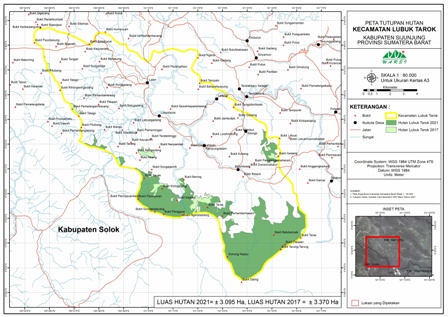
Sentinel Image Analysis-2 KKI Warsi
Meanwhile, Sentinel-2 Image Analysis from the Indonesian Conservation Community (KKI) Warsi, the rainforest covering area in Lubuk Tarok District in 2017 were approximately 3,370 hectares and in 2021 it were approximately 3,095 hectares.
The conversion of rainforest functions for plantations by the community continues. Such as land clearing for a 40-hectares lemongrass garden in Nagari Lubuk Tarok in 2019, which borders with Nagari Latang.
In addition, dozens of sawmills (wood processing businesses) operate in Lubuk Tarok District. The supply comes from large trees in the forest of the sub-district and its surroundings--such as from the rainforest in Nagari Sariak Laweh, Solok Regency. Meranti is one of the wood species supplied, and is a kind of Sialang trees.
"In Lubuk Tarok District, Sawmill UD IDK which has a permit from the Production Forest Management Center (BPHP) Region III Pekanbaru. It's official from the state. As for the other sawmill permits, I don't know about the legalization," said Head of KPHL Sijunjung Yandesman, Wednesday (29/29/2011). 6/2022).
Yandesman also said that currently KPHL Sijunjung does not have a wild bee and honey bee conservation program yet. They are currently cultivating galo-galo honey (Apis trigona), because it is hype right now.
Apis dorsata Biodiversity Nurse
Apis dorsata or giant honeybee thrives in sub-tropical and tropical Asia. In Indonesia, Apis dorsata can be found in Sumatra, Kalimantan, Sulawesi, Papua, and Nusa Tenggara.
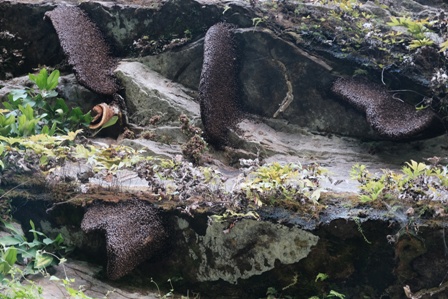
Wild bee in Nagari Latang Sialang Rocks (Captured by Yethendra BP)
According to Dr. Jasmi, Minangkabau people (the majority ethnic group in West Sumatra) called Apis dorsata, the away bee because it moves around and the kabau bee because of its large size.
They called it the Sialang bee because it tends to nest in trees and rocks, and their enemy is eagles (in local language alang means eagle). Wild bees put their nest in the hollows of the rock cliffs to avoid eagles. Or they’ll put it in slippery trees to avoid bears.
The wild bee nest is built by one comb, consisting of 15,000-20,000 worker bees, queen bees, child bees, and males.
"Quoting from the Philosopher Aristotle, when bees disappeared human will extinct. If we analyze it, more than 80 percent of plants need pollinators to mating male and female flowers. Bees are the pollinators. The process of pollination by bees is priceless. In Europe farmers have rented bees (Apis mellifera) for pollination, and they get better income from it than selling honey," said Dr. Jasmi who is also a Lecturer for STIKES Indonesia Padang. Actually, maybe he want to quote Albert Einstein that state, “If the bee disappeared off the surface of the globe, then man would have only four years of life left. No more bees, no more pollination, no more plants, no more animals, no more man.”
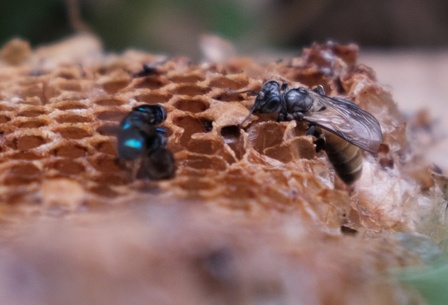
Apis dorsata in their nest after the harvest (Captured by Yethendra BP)
Pollination is an important factor for plant reproduction. When collecting nectar, flower pollen sticks to the bees. When a bee visits another flower, the pollen from previous flower will stuck to it.
Apis dorsata helps the plant and get their food from it, maintains ecosystem stability, and cares for the biodiversity of tropical rainforests.
But if the deforestation continues, no more bees, no more plants, no more man.***
Biodiversity Reportage in this Tropical Rainforests was produced with the support of the Rainforest Journalism Fund in collaboration with the Pulitzer Center.





